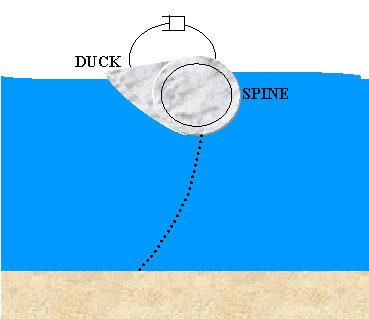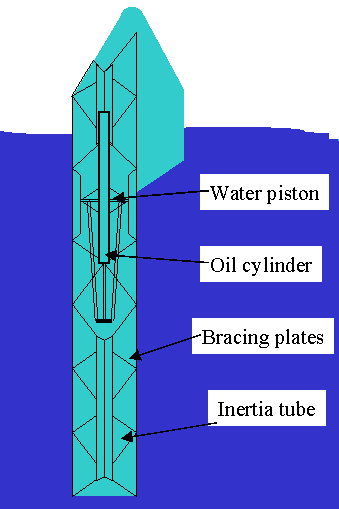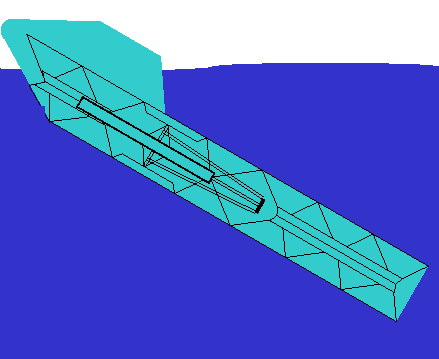WAVE
(the conversion of the power of ocean waves to electricity)
Introduction
It was estimated that the power in a wave front can be as much as 70 kW/m and could
form part of the renewable alternative to fossil fuel
for power generation, especially considering wave energy conversion is a clean technology
with negligible CO2 emissions.
There has been recent international interest in the research and development of ocean
energy systems and it is envisaged that the ocean could be a major energy resource for the
21st century.
The European Commission has observed the wave energy field since 1983 and
provided a source of funding for the R&D of Wave Energy Converters (Wave E.C.). The first international wave energy symposium was held in Edinburgh and was established
to provide a link between the scientific community and related industry interested
in the development of MW scale ocean energy systems. The latest conference, held in
Patras, Greece in 1998 again provided the platform for scientists and financiers to
evaluate the progress made and exchange views on future ideas.
Wave energy is currently being used to generate electricity on the shore-line and off-shore.
On the shore-line, an Oscillating Water Column (OWC) has been generating electricity
successfully on Islay since 1995 and fog and light buoys have been successfully used
offshore for a number of years providing navigation aids to sailors.
While shoreline machines are showing tremendous promise (3 Renewable Orders included
in the 1998 Scottish Renewable Order), most researchers agree that the real potential will only be
realised when wave machines move offshore, where wave energy is highest.
Obviously, offshore installations are ideal locations to exploit this power and a
review was carried out to establish the feasibility of using Wave EC’s to provide the
power to generate electricity offshore.
The potential of converting the kinetic and potential energy of the sea into electrical
energy has been researched for many years. Frenchman Girard patented the first WEC in
1799 where the proposed invention consisted of a simple raft which would move up and down
by the power of the waves, connected by numerous wires and pullies to a shoreline device.
It has only been recently, some 200 years later that reliable, efficient and cost effective
WEC devices are now entering the commercial marketplace even though it is a high
quality renewable resource (99% of the energy can be used) .
Suitability to offshore installations
A meeting was arranged with Jamie Taylor at Salters lab, Edinburgh to help us establish
the state of the art devices which may be suitable for generating electricity on or
around an offshore installation.
Description
Shoreline WEC: are fixed to a suitable location on a coast-line and generate electricity
by the conversion of air trapped in a chamber which is released through a small aperture
to drive a turbine.
It was envisaged that the converter could be fixed to the legs of the installation,
at sea-level, to generate electricity from the continual movement of the waves.
Further to the review of lateral loading of offshore installations it was established that
the lateral and vertical forces could jeopardise the stability of the offshore installation
and the concept was deemed unfeasible.
Floating WEC: are floating devices normally tethered to a fixture on the sea-bed.
Various devices have been developed which include the generation of electricity from waves
through the inflation of a bag to trap and release air (as above) or mechanically driving a motor/ pumping
fluids by the differential motion of the waves. As some devices could be tethered to the seabed, this would not cause any unnecessary
lateral loading on the installation and therefore could appear to be a viable RES.
The offshore installation would be in this case an ideal substation / maintentance platform.
Current devices include:
Salters Duck (designer Stephen Salter):

| The original device was first invented in the 70’s
and has undergone continual development since.
The latest ‘Duck’ consists of dozens of pistons fixed inside a cylinder which are pushed in
and out by a ring of cams fixed to the moving float. This arrangement works by using highly
specialised digital hydraulics which juggles the pressure inside many hydraulic circuits,
turning the slow bi-directional movement of the float into the constant high speed rotation
of a generator.
The recent device has an efficiency of approximately 65% and is more reliable than ever.
Up to 24 ducks can be laid out in series along a concrete spine which will require a
structure or the seabed as a mooring point.
Due to the complicated design it is expected that it will take more years of development
and is reckoned to be ‘next generation’ device.
|
Bending Spine WPT-375 (designer Richard Yemm):
This new concept unveiled his new design for the first time at the 1998 IWEC and we have had the privilege of witnessing
the prototype in Salters lab, Edinburgh.
The device generates electricity from differential motion from 10 buoyant tubes
(stabilised by denser material attached to the underside) placed end to end to form a spine
measuring 120 m long.
Each device is expected to generate 375 kW of electricity and sea trials will be taking
place in the near future to determine the overall effectiveness of such a system.
Osprey (designer ART, Inverness):
This stand alone wave machine is a second generation device based on the original OSPREY design. The original OSPREY was a 2 MW device but was
unfortunately wrecked by waves during 1995 when it was taken out on its first sea trial.
Sea trials for the second generation machine will be carried out shortly.
Powerbuoy (ART, Inverness, Scotland):
This device is expected on the market in the near future and the design cannot be revealed until patents are secured. The minimum depth required for deployment is 150 feet, while there is theoretically no maximum. It is reckoned that they can produce several megawatts of power, depending on location. One potential use for the Powerbuoy as suggested by Lee-Young (Oil & Gas Journal 19th October 1998) could be to provide power to oil and gas installations, where conventional gas or diesel generation would prove prohibitvely expensive.
IPS Buoy
Stephen Salter,
Technocean (Sweden) & OPT America:

| 
|
This concept consists of a float connected below to a weighted vertical tube. Inside the tube, which is open
to the sea at both ends, is a piston which extends upwards to the float. Out at sea, the
float and tube move up and down more vigorously than the piston and again the difference
in motion is converted to electricity.
Stephen Salter has found that by locating the buoys at an angle from the vertical
can increase the machines efficiency.
Sea trials of 10 x 30 kW Technocean devices is expected to be carried out in the Greek
Island of Amorgos this year.
|
|
Shim Hybrid (designer Hyun Jin Shim):
An array of floating buoys each anchored to a central shaft. The rope is wound onto a drum inside a buoy which behaves like an
upside down yo-yo. As the buoy falls and rises, the drum drives a generator.
Suitable locations
The suitable locations for wave corresponds to the wind potential as identified in the 'wind' review.
Limitations
Loading:
Floating devices, by their very nature, do not require to be fixed to a
structure however they do require a mooring point by high tensile cable to avoid
them floating away.
The devices should ideally be located to a tethering point on the seabed.
Storms
Wave devices can be badly affected by storms and every precaution should be taken
to protect the expensive machinery from damage. The selection of a suitable device
will depend on its ability to deal with the offshore conditions of a specific location.
Possible Solutions
Loading:
Should tethering the devices to the seabed prove unfeasible i.e. the depth of water was
too great or a lateral mooring point was required a full structural analysis of the loads
imposed by the floating Wave ECs acting against the structure would have to be carried out to
establish the overall feasibility of tethering the floating devices to the structure.
Storms:
Ideas proposed include intentionally 'sinking ' them until the storm blows over, towing
them to shelter or to raise them onto the deck during this period.
The suitability of the device should initially be assessed on the ability to cope with the
worst case weather conditions faced in a particular ocean.
Cost effectiveness
As many devices are being reviewed for trial, accurate costs for individual machines are
not known.
It has been calculated that the cost of electricity from wave power is expected to be
economically viable i.e. in the region of 5 p/kWh.
For offshore devices, rated outputs in the MW range are likely to prove most cost effective.
Environmental aspect
Offshore devices would have little or no visual impact and for the forseeable future effects
on coastal currents and wave climates are likely to be small (although large devices could have a
notable effect).
They could however interfere with shipping, especially fishing vessels.
On the other hand, the floating devices could {potentially}provide shelter to fish/fauna
thereby assisting with the regeneration of depleting fish stocks.
Conclusion
It has been established that an immense amount of power could be generated from the waves. The
resources around the UK are estimated to be 1000 TW per year.
While offshore platforms are designed to minimise wave loading, wave energy converters would transmit significant wave loading forces to their moorings. With this in mind it would not be feasible to use offshore platforms as mooring points
for wave energy converters. It is possible however that these platforms could be re-used as bases for maintenance and transmission operations if proven large scale floating wave devices were implemented. These devices would although have to be tethered to the seabed.
It is hoped that the devices undergoing sea trials in the near future will provide further information as
to the effectiveness of Wave ECs in harsh offshore environments and provide accurate information of the
strength and power take off from each device.


